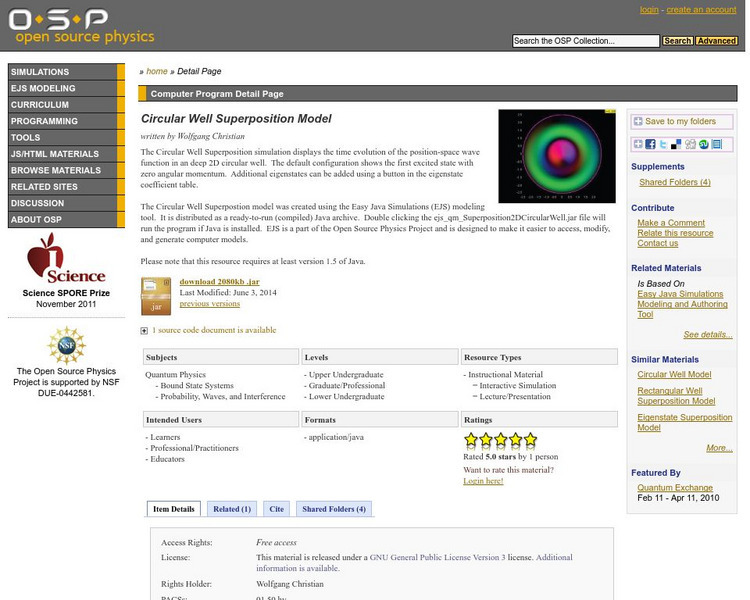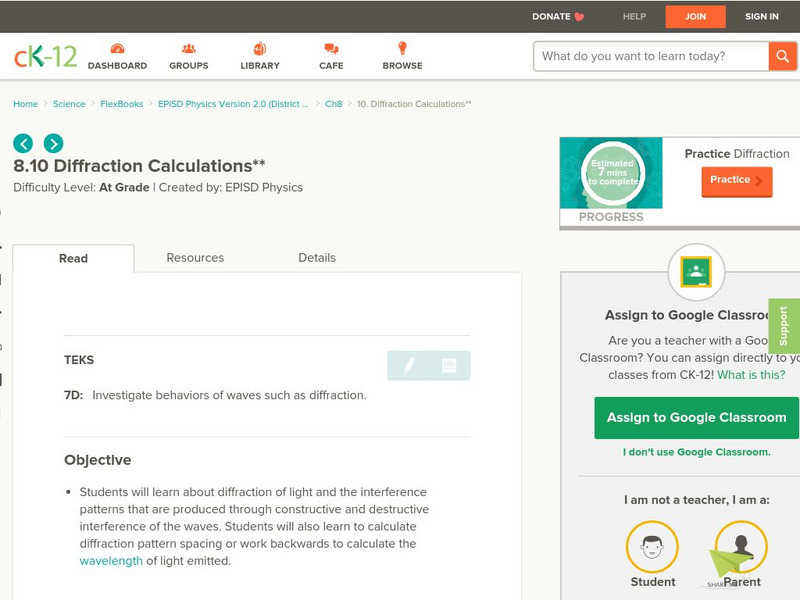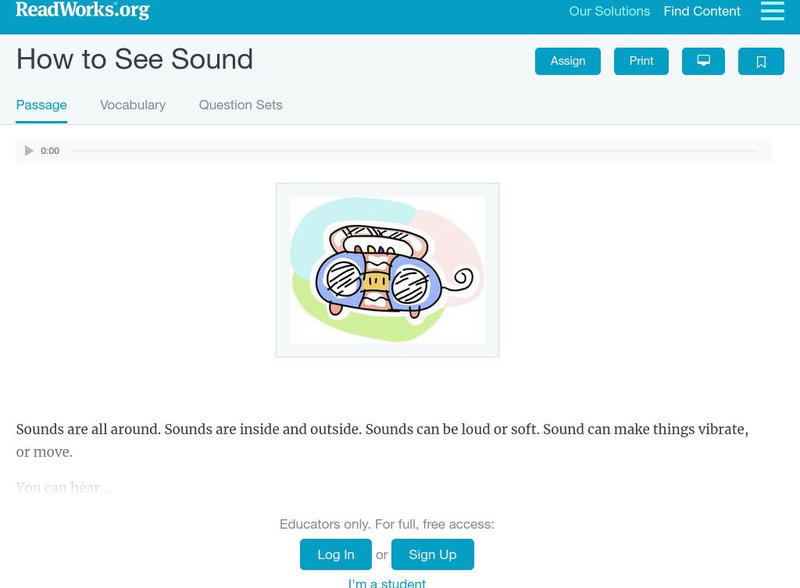Physics Classroom
The Physics Classroom: Properties of Periodic Motion
In Physics, a motion that is regular and repeating is referred to as a periodic motion. Most objects that vibrate do so in a regular and repeated fashion; their vibrations are periodic. Learn more here about periodic motion and take the...
University of Colorado
University of Colorado: Physics 2000: X Rays
Here's a really simple demonstration of a fluoroscope. There are links to more information about the uses of X-rays as well.
American Association of Physics Teachers
Com Padre Digital Library: Open Source Physics: Circular Well Superposition
A simulation that displays the time evolution of the position-space wave function using the Circular Well Eigenstate Superposition model.
Ducksters
Ducksters: Physics for Kids: Basics of Sound
Kids learn the basics of the science of sound, the speed of sound, and volume. What is sound and how does it move? It is a wave made from the vibration of molecules.
Nobel Media AB
The Nobel Prize: The Quantised World
After an introduction, this site breaks down into sections discussion quantum theory, including A Quantum Theory for Energy, A Quantum Theory for Atomic Structures, Waves or Particles, Quantum Mechanics, and Interpreting the Quantum World.
CK-12 Foundation
Ck 12: Diffraction Calculations
[Free Registration/Login may be required to access all resource tools.] Students investigate diffraction of light and the interference patterns that are produced through constructive and destructive interference of the waves. Students...
CK-12 Foundation
Ck 12: Doppler Effect
[Free Registration/Login may be required to access all resource tools.] Students investigate behaviors of waves, and explore the Doppler effect phenomenon.
Physics Classroom
The Physics Classroom: Waves: Energy Transport and the Amplitude of a Wave
Students explore the energy transport phenomenon that transports energy along a medium without transporting matter.
Oklahoma Mesonet
Oklahoma Climatological Survey: Overview of Radiation
This site details what radiation is, the physics of radiation, and radiative transfer as it occurs in nature. Content explores the electromagnetic spectrum, electromagnetic waves, properties of radiation, and solar radiation.
Physics Classroom
The Physics Classroom: Wave: Mathematics of Standing Waves
Students analyze harmonic patterns through several example problems and interactive practice examples.
University of Colorado
University of Colorado: Physics 2000: Electromagnetic Waves
An excellent site with several pages describing what electromagnetic radiation is.
Khan Academy
Khan Academy: Light: Electromagnetic Waves, Electromagnetic Spectrum and Photons
This article discusses the properties of electromagnetic radiation and photons.
Physics Aviary
Physics Aviary: Practice Problems: Frequency for Standing Waves on a String
Determine the frequency needed to produced a given harmonic on a string with a given length, mass and tension.
TeachEngineering
Teach Engineering: Wind Chimes
Using their knowledge of physics, students will build a wind chime. Mathematical computations will be done to determine the length of the pipes.
Wolfram Research
Wolfram Science World: Maxwell, James
This ScienceWorld site describes the Scottish mathematician and physicist James Maxwell (1831-1879) who published physical and mathematical theories of the electromagnetic field.
Concord Consortium
Concord Consortium: Stem Resources: How Loud, How High?
What are ways to describe sound? Using the program downloaded called Sound Grapher and the microphone on the computer, students can investigate the frequency, wavelength, amplitude, and velocity of sound waves. Activity includes detailed...
Read Works
Read Works: How to See Sound
[Free Registration/Login Required] An informational text showing how to see sound waves. A question sheet is available to help students build skills in reading comprehension.
University of Guelph
University of Guelph: Physics Tutorials: Amplitude, Period, and Frequency
A tutorial describing the characteristics of simple harmonic motion. Utilizes animations, mathematical equations, and interactive questions to teach essential principles.
Physics Aviary
Physics Aviary: Beats Lab
This lab is designed to help students visualize the formation of beats and the relationship between the number of beats per second and the beat frequency heard by the observer.
Physics Aviary
Physics Aviary: Radiant Emissions Lab
This lab is designed to allow students to look at the relative proportions of different wavelengths of light that are emitted by stars at different temperatures.
Physics Aviary
Physics Aviary: Distance to Destruction Lab
This lab is designed to help students visualize distance between two synchronized sources that will lead to constructive and destructive interference.
OpenStax
Open Stax: Catherine Schmidt Jones: Sound and Music
Introduce some activities that introduce students to the physics of sound. They will also learn how various instruments produce sound. Included are downloadable pdf worksheets and answer sheets to use.
Physics Classroom
The Physics Classroom: Pendulum Motion
This tutorial investigates pendulum motion and how a variety of quantities change over the course of time. Such quantities will include forces, position, velocity and energy - both kinetic and potential energy. Take the interactive...
CK-12 Foundation
Ck 12: Physical Science: Microwaves
[Free Registration/Login may be required to access all resource tools.] Microwaves and their uses, and how cell phones and radar work.
Other popular searches
- Waves Physics
- Waves Physics Tsunami
- Sound Waves Physics
- Energy Waves Physics
- Waves Physics High School
- Waves Physics Radio Waves
- Inquiry Based Physics Waves
- Waves Physics Practical
- Latitudinal Waves Physics
- Waves Physics Pictures
- Waves Physics Worksheets
- Waves Physics Gallery
















